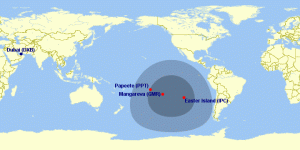tmount
Administrator

I’m finding myself traveling to the Middle East, or more accurately, through the Middle East a whole lot more than I used to. I’m noticing others flying to or via the Middle East as well. So far as I can tell, here are a few reasons:
- The three major airlines – Emirates, Etihad Airways, and Qatar Airways are putting out very nice, largely new products, such as the A350, 787-9, 787-8, a380, and I’d also put the 777-300ER in that group.
- The three major hubs in the Middle East are ~10-16 hour flights to/from the US, which allows enough time to eat, sleep, and relax when traveling in a premium cabin. Even the shorter flights to Europe or Asia still allow enough time to enjoy the flight.
- Its a whole lot easier to connect with fewer hassles than I can in Europe (I’m looking at you, London-Heathrow!). Generally, you can make a single stop trip.
- You generally still get a nice product for your onward connection, unlike if you fly to Heathrow then on to Rome, or Hong Kong to Phuket (although I think Dragonair has layflat seats).
- More fifth freedom routes mean that you can often fly on the same carrier further (as if the more single flight connections wasn’t enough).
Emirates is based in Dubai, United Arab Emirates, and is most known for their A380’s, they kind’re kind’ve keeping Airbus’ production going (barely). Having flown on the A380 not once, but twice, its really a great product. Emirates also has a number of partnerships, most notably with Qantas.
Etihad Airways, based just up the road in Abu Dhabi, United Arab Emirates, created (and continues to grow it seems) its own Etihad Partners Group, through partnering and equity purchases. They also recently surpassed all other A380 operators, with their new A380. Lucky was on the inaugural, he’s probably got the best report of it so far.
Qatar Airways, based in Doha, Qatar (duh!), joined the Oneworld Airline Alliance, aligning it with American Airlines, British Airways, Cathay and Qantas among others.
Looking at the way commercial aircraft (or at least airline purchases) are moving:
The latest clean sheet aircraft (and perhaps the last ones for quite a while) were the 787 and the A350. Both wide-body, fuel efficient, and reasonably long range aircraft. So far with the 787, we’ve seen airlines announce long thin routes, like British Airways’ London-Heathrow (LHR) to Austin (AUS), and United’s San Francisco (SFO) to Chengdu, China (CTU). Great Circle Mapper had a great graphic of the upcoming 777-8X’s range which paints another reason for why the Middle East is a logical connection point for long haul travel:

Range of the 777-8X and 777-9X.
Map generated by the Great Circle Mapper – copyright © Karl L. Swartz.
We’ve also see talk of Airbus slowing or eventually stopping A380 production, and Boeing continues to slow its production rate of the 747-8.
It’ll be interesting to watch the big three Middle East carriers adapt. Just last week at the A350 unveiling, Airways News reported that Qatar Airways CEO, Akbar Al Baker stated he wants to aggressively replace aircraft. Emirates’ CEO Tim Clark continues to be supportive of the A380, and I’m not really sure about Etihad, but based on their Fast Facts and Figures (page 4), it looks like they’ll be adding a ton of aircraft through 2025, primarily more fuel efficient widebodies.
Wrapping up
So long story short, the big three Middle East carriers are making it much more comfortable, if not convenient to fly long distances, through their products, their partnerships, and their aircraft.
Continue reading...
